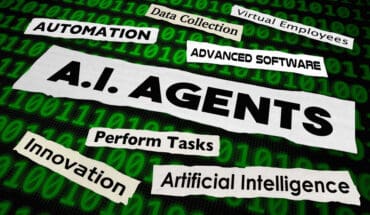
Generative AI can be leveraged to develop improved and enhanced user experiences and drive innovation.
As someone who has been at the forefront of mobile app development leadership for over a decade, I have had the opportunity to witness the rapid evolution of the mobile landscape. From the early days of clunky feature phones to the current era of powerful and omnipresent devices, innovation has continuously driven the industry. However, in recent times, there has been a noticeable shift in the conversation. The emergence of Artificial Intelligence (AI), and particularly Generative AI, has generated a mix of excitement and concern, particularly regarding its potential impact on employment within the technology sector.
I used to be concerned about how AI would impact our skilled team of developers and designers. But those worries have turned out to be unnecessary. Instead of replacing our team, AI has become an integral part of it. We are experiencing the beginning of a new era – one in which humans and AI work together – and it is fundamentally changing how we approach innovation in mobile app development. This collaboration has allowed us to automate repetitive tasks, analyze data on a larger scale, and create more personalized user experiences. It has also freed up our team to focus on more creative and complex problem-solving, ultimately leading to more innovative and impactful mobile app solutions.
See also: Deriving Layers of Value from GenAI Applications
The Power of Generative AI
Let’s address a common misconception: AI is not intended to render human roles unnecessary. Envision a scenario where AI takes on the burdensome, repetitive tasks that hinder the app development process. Generative AI, a specialized branch of AI dedicated to producing entirely original content, is particularly well-suited for this purpose. Whether it’s generating code or creating design prototypes, generative AI has the potential to streamline workflows and liberate developers to concentrate on the more inventive aspects of app development.
Here are five practical ways businesses, not just in mobile app development, can use the power of generative AI to innovate today:
1. Streamline Content Creation
The marketing industry relies heavily on content creation, including engaging blog posts, captivating social media captions, and informative product descriptions. These forms of content are essential for building brand recognition and attracting new customers. However, consistently producing high-quality content can be time-consuming and resource-intensive for marketing teams. Generative AI technology offers a valuable solution by providing support in generating content, thereby easing the burden on marketing teams and enabling them to create compelling material more efficiently.
AI tools can help marketing teams by automating tasks like writing blog posts, creating social media content, and writing product descriptions. This frees up time for the teams to focus on strategy and creativity.
In a recent collaboration, our company joined forces with a cutting-edge generative AI content creation platform to craft compelling product descriptions for our latest mobile application. Leveraging the power of AI, the platform meticulously analyzed competitor descriptions, user reviews, and market trends to produce one-of-a-kind and informative content in a significantly reduced timeframe compared to traditional human writing methods.
2. Design with Efficiency
The user interface (UI) and user experience (UX) are the cornerstones of any successful mobile app. An intuitive UI that’s aesthetically pleasing and a UX that seamlessly guides users toward their goals is essential for driving engagement and positive user reviews. However, crafting the perfect UI/UX can be an iterative process, often involving numerous rounds of brainstorming, prototyping, and testing. This is where generative AI steps in, acting as a creative catalyst for UI/UX designers.
Imagine a scenario where AI can take your initial design vision and user data, then generate a multitude of unique UI/UX variations in a fraction of the time. This allows designers to explore a broader range of possibilities, identify potential pitfalls early on, and ultimately arrive at the optimal design solution faster.
- Bridging the Gap Between Vision and Reality: Designers often have a clear vision for the overall user experience, but translating that vision into concrete UI elements can be challenging. Generative AI tools can bridge this gap by analyzing initial design specifications, brand guidelines, and user research data. Using this information, the AI can generate various UI mockups that capture the essence of the designer’s vision while exploring different visual styles and layout configurations.
- Exploration Made Easy: Traditionally, iterating through different design ideas involves manual mockup creation, a time-consuming process. Generative AI tools eliminate this bottleneck. By feeding AI-specific design constraints and user data, designers can generate a plethora of design variations within minutes. This allows them to explore a wider range of possibilities and identify potential usability issues early in the design process.
- Sparking Creative Inspiration: Sometimes, the most innovative design solutions come from unexpected places. Generative AI can play a crucial role in sparking creative inspiration. By presenting designers with a diverse array of UI/UX variations, AI can nudge them outside their comfort zone and introduce design concepts that might not have emerged through traditional methods. This cross-pollination of ideas can lead to truly groundbreaking UI/UX solutions.
Recently, one of our clients approached us seeking a refresh for their mobile app’s interface. They had a general idea of the desired outcome – a more modern look and feel that would resonate better with their target audience. However, they were unsure about the specific design elements and layouts that would achieve this goal.
To accelerate the design process and explore a wider range of possibilities, we employed a generative AI design tool. We fed the AI with the client’s brand guidelines, user data, and initial design ideas. The AI then generated a multitude of layout options, each showcasing a unique combination of UI elements and visual styles.
The results were impressive. Not only did the AI-generated variations save us significant time compared to traditional methods, but they also presented several design concepts that the client hadn’t even considered. These unexpected ideas sparked a lively brainstorming session, ultimately leading to a UI refresh that exceeded the client’s expectations. The new interface was not only visually appealing but also significantly improved user engagement metrics.
3. Personalize the User Experience
Generative AI offers a powerful solution for mobile app developers, enabling them to create personalized experiences that truly resonate with users. Imagine an app that can analyze a user’s behavior, preferences, and real-time data to dynamically curate content, deliver targeted notifications, and even adjust the user interface for a truly customized experience. This is the future of mobile apps, and generative AI is the key to unlocking its potential.
Generative AI tools can analyze vast amounts of user data, including past behavior within the app, search history, and location information. By identifying patterns and user preferences, the AI can build a detailed user profile. This profile becomes the foundation for personalization initiatives.
Gone are the days of generic content recommendations. Generative AI can analyze a user’s profile and leverage real-time data (like current location or weather conditions) to suggest content that is truly relevant and engaging. Imagine a travel app that recommends nearby restaurants based on a user’s past culinary preferences and the current weather. Or a news app that curates a personalized feed based on a user’s reading history and interests.
Push notifications can be a powerful tool for user engagement, but generic notifications often get ignored or even deleted. Generative AI can personalize push notifications based on user data and behavior. This can include reminding users about abandoned items in their shopping cart or notifying them about relevant deals and promotions based on their purchase history. By delivering timely and relevant notifications, businesses can increase user engagement and drive conversions.
Imagine an app that dynamically adjusts its user interface based on a user’s preferences. Generative AI can analyze user data to determine which features are used most frequently and personalize the layout accordingly. This not only improves user experience but can also encourage exploration of lesser-known app features.
4. Customer Service with AI-powered Chatbots
In the past, customer service heavily relied on human agents, resulting in prolonged wait times and frustration for customers. However, with the advent of generative AI chatbots, a viable solution has emerged. These advanced chatbots can undergo extensive training using vast amounts of customer data, enabling them to engage in meaningful conversations and provide support.
They excel at handling routine inquiries, addressing frequently asked questions, and even tailoring responses to individual customers based on their history and preferences. As a result, human agents can dedicate their time to tackling complex issues and delivering a more personalized service when necessary. Furthermore, generative AI technology is capable of analyzing customer interactions, thus pinpointing areas for improvement and ultimately leading to a more efficient and customer-centric service experience.
5. Enhance App Functionality with Code Generation
Generative AI, although still in its early stages, is demonstrating potential in the generation of code. AI tools can analyze existing code patterns and functionalities to generate boilerplate code or propose solutions to coding challenges. This has the potential to significantly enhance developer productivity, enabling them to concentrate on the development of more intricate application features.
The Future is a Collaboration
The future of mobile app development and the entire tech industry is not a matter of humans competing against machines. Instead, it’s about humans and machines forming a strong partnership. By incorporating generative AI as a valuable tool, constantly learning, and refining our distinct human abilities, we can unleash a future filled with innovation, productivity, and mobile experiences that are focused on the needs of the user.
As the technology continues to evolve, we can expect even more innovative ways to utilize its power. The key for businesses is to stay informed, experiment with these tools, and find ways to integrate them into their existing workflows.






























